#gender wage gap
Photo
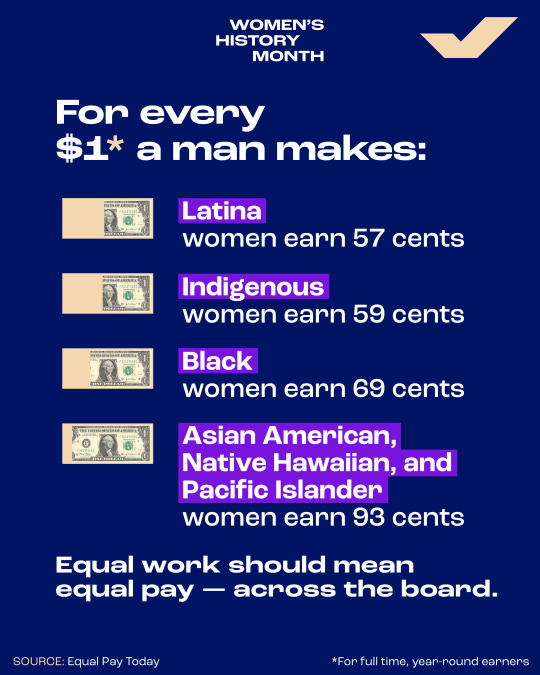
Today is Equal Pay Day. On average, a woman in the U.S. has to work until today — March 12th — to earn what a man was paid in the year prior. 🪙🙅🏽♀️💵
This #EqualPayDay, join us in bringing awareness to the gender wage gap, which is even wider for women of color.
The politicians WE elect can implement reforms that address pay inequality across industries. Make sure you’re registered to vote NOW at weall.vote/register.
#equal pay day#equal pay#equal pay today#pay gap#wage gap#pay inequality#register to vote#vote#voting#gender wage gap#equal work#equal work equal pay
216 notes
·
View notes
Text
It’s taken Manitoba women from Jan. 1, 2023 until April 4, 2024 to make the same income as their male colleagues did last year.
Numbers from the Canadian Centre for Policy Alternatives (CCPA) show that, on average, women make $0.71 for every dollar a man makes, setting them back three months on an annual basis.
Molly McCracken, Manitoba Director of the CCPA, said racialized women make even less.
“Indigenous women earn $0.58 on the dollar compared to a white man, and women of colour earn $0.59 on the dollar,” she said, adding that none of these numbers have changed markedly in the past 30 years.
The impacts, she said, are not isolated to someone’s pocket. [...]
Continue Reading.
Tagging: @politicsofcanada, @vague-humanoid
Notes from the poster @el-shab-hussein: I'm pretty sure "women of colour" here is supposed to mean Black, but liberals are allergic to acknowledging blackness or anti-blackness so they won't say that. Just a disclaimer.
143 notes
·
View notes
Text
1 Easy Way All Allies Can Help Close the Gender and Racial Pay Gap
Keep reading.
If you liked this article, join our Patreon!
32 notes
·
View notes
Text
By: Payman Taei
Published: Jan 22, 2019
Every year, the Department of Labor issues a report on the pay gap between women and men.
Women earn a median of $30,000[1] per year, while men earn $40,000 per year. In other words, working women earn 75% of what men earn.
But this gap doesn’t take into account the fact that on average, men work more hours than women. According to U.S. census data, men spend an average of 41.0 hours per week at their jobs, while women work an average of 36.3 hours per week.
Many argue that gender discrimination explains a large part of the difference in earnings. Others argue that parenthood and gender roles usually affect women’s earnings more than men.
To better understand the pay gap, we classified the respondents according to their marital and parenthood status2. The gap is dramatically higher between married couples versus singles without children. For married parents, the gap is even greater.
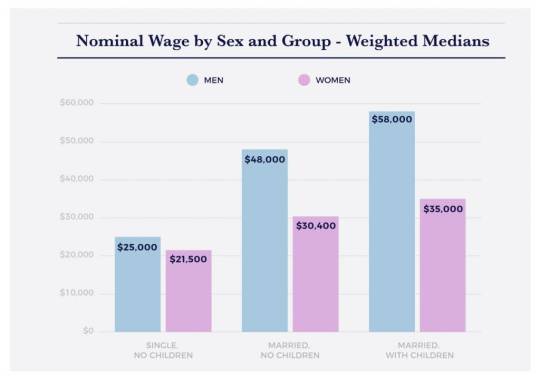

But we also found that married fathers work even more than other men, while married mothers work less than married women without kids.
We analyzed the pay gap across hundreds of U.S. occupations. According to our research, in most occupations, the main source of the pay gap lies in the difference between the number of hours spent at work by women and men, and marital status and parenthood explain almost all this difference in working times.
The different behavior of women and men3 has an impact on the gender wage gap. As we will see below, the decision of who does most of the work outside versus who stays at home influences the pay gap in two ways: it modifies the nominal income, but it also influences how much women and men earn per each hour worked4.
A few specific examples
Let’s take a look at the most common occupation in the US: Managers. This occupation is representative of the overall trend we see in the United States.

Single male managers without kids earn a median of $60,000 per year, while single female managers without kids earn $58,000 per year. On average, single male managers work 43.7 hours per week, while single female managers work 42.3 hours per week.
This means that men earn 3.4% more but work 3.5% more hours per week.
But when we look at the pay gap between married couples, we see a different picture. Both female and male married managers do have a higher salary. But men earn much more than women.

Male married managers without kids earn a median of $90,000, while female married managers without kids earn a median of $62,000. A pay gap of 31%. In other words, women earn $0.69 for each dollar earned by their male counterparts.
A large part of this gap is explained by the number of hours spent at work. Men tend to work more after they marry. The average weekly working hours of males increase 4.3%, while women keep working the same quantity of hours per week. This explains a part of the gap increase.
But the time spent at work does not explain all of the gender pay gap. Married men managers without kids also earn more for each hour at work: they earn $38.40 per hour while married women without kids earn only $28.70. That means that for each hour spent at their jobs, male married managers without kids earn about 34% more than women. As we will see in detail below, the different hourly rate is related to job market trends.
We can see the same pattern across occupations like school teachers, secretaries, nurses, customer service representatives, and a lot of other professions: a small pay gap for singles without kids and a larger pay gap for married people.
Exceptions to the overall trend
We have seen that, for the most common occupations, there is almost no absolute pay gap for singles without kids, and this gap could be explained by the difference in time spent at work. But there are some occupations that do show a gap for this group of people.
Notable examples are drivers, retail salespersons, supervisors and janitors. Interestingly, we can see the same general pattern in these occupations: the uncontrolled gap increases dramatically for married couples, even if they do not have kids.


The same general pattern repeats itself in occupations where single women without kids earn more than their male counterparts. Some of them are secretaries, customer service representatives, cooks, stock clerks, office clerks and receptionists.

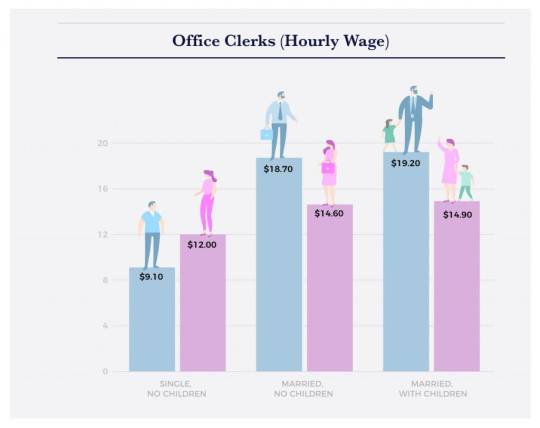
In all of these occupations, the pay gap in favor of women reverts if they marry: married men still earn more than married women.
More time at work also means higher wages
Now, let’s look closely at the different hourly wages paid to women and men. The data shows that there is a persistent difference in the hourly rate earned by women and men, specially for married women and men. But the data also shows that men work more than women.
After taking a closer look at the data, we found a relationship between the hourly wage and the time spent at work. The average hourly pay increases as the number of hours worked per week increases. This is true for both sexes.
In the following chart, we plotted the hourly pay for women and men. To isolate the effect of marriage and parenthood, we took into account only singles without kids.

In the next chart, we can see the average number of hours worked for each group:

For the relevant range of hours worked per week, the average hourly pay increases as the time spent at work increases.
Because men tend to work more hours than women, especially if they are married, and even more if they are married parents, this could explain a large portion of the pay gap.
Also, the previous chart shows that on average, single women without kids are getting paid more than men for every hour spent at work. This could mean that if women worked the same amount of hours as men do, and other conditions remained the same, there would be no pay gap for this group 5.
What about age and experience?
It is important to note that age and job experience are also relevant factors in the gender gap debate. To isolate the possible effects that age and job experience may have in the pay gap for each of the different groups, we plotted the weighted average of working hours per age for single women and men without kids.
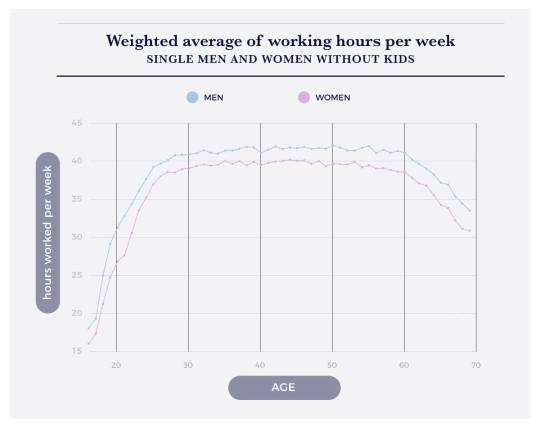
For singles without kids, there is a very small gap at every age. But for married couples, there is a significant gap in working hours at every age.


If we take into account how the hourly wage varies as men and women get older, the hourly wage of men increases more than the hourly wage of women. The same pattern can be seen in all three groups.



The charts above demonstrate that job experience is correlated with the time spent at work through the years. As years pass, men accumulate more practice and training than women. The job market pays more if the worker has more experience. In other words, the gap widens as men acquire more experience than women.
So what’s the real cause of the gender wage gap?
In this article, we found that one of the main sources of the gender pay gap is the fact that, on average, women and men devote a different number of hours to their jobs, specially after marriage and parenthood.
The literature on gender pay gap is very extensive. Different papers focus on diverse causes to explain it. Two of the most mentioned reasons are gender discrimination and motherhood and gender roles.
Gender discrimination against women occurs if a woman is paid less than a man for doing the same job.
If we consider that the quantity of hours devoted to a job determines whether we consider a job to be the same as another, the data doesn’t support the idea of gender discrimination at the aggregate level.
The hourly pay rate for married women is lower than for married men on average, but a probable explanation is because the job market pays less per hour if the number of hours worked decreases, and married women tend to work less. The same pattern can be seen in almost every occupation.
Also, men tend to devote more time to work, thus acquire more experience as years pass by, and the job market pays more if the worker has more experience.
This doesn’t mean that gender discrimination doesn’t exist. Our analysis just shows that, at the aggregate level, most of the gap is not explained by gender discrimination.
Regarding the second aspect of the pay gap, societal ideas of gender roles influence the behavior of women and men. Also, biological factors related to parenthood do play a role in the creation of differences in preferences. Namely, women get pregnant and women breastfeed. These differences between sexes could be a plausible explanation of why women tend to spend more time at home versus their couples, especially after marriage and parenthood6.
To conclude and to recap, we can say that, according to our analysis, job market forces and gender preferences in relation to marital status and parenthood could explain almost all of the pay gap. Most of the gap is not the result of gender discrimination.
Notes and Methodology
[ See here. ]
==
The "gender pay gay," like the resurrection of Jesus, is a tenet of faith, not a demonstrable reality. It's touted by Gender Studies majors and ideologues, not anyone with basic economics background (which is why they don't encourage or require numeracy in Gender Studies).
It's also disturbing how little respect the myth's proponents have for women's (and men's) choices and needs, valuing only money not lifestyle or fulfillment. Ironically, these people are usually staunch anti-capitalists, denouncing "shallow materialism" from one side of their mouth and demanding more money and free stuff from the other side.
#Payman Taei#myth of the wage gap#wage gap myth#wage gap#gender wage gap#feminist lies#gender discrimination#pay gap#gender pay gap#myth of the pay gap#pay gap myth#religion is a mental illness
3 notes
·
View notes
Text
Can we stop with the classist jokes about someone living with their parents? Rents are extremely high right now, so it's wrong to assume that somebody is choosing to do that.
It's also wrong to assume that there's a correlation between how much money somebody has and how hard they work.
What's worse is that it's assumed to be a cis man while a woman is always able to be financially independent, which ignores the reality of the wage gap between cis men and marginalized genders. Race is also a factor.
There's also the fact that is someone is aspec and/or has ND social inability, they've likely never had a long term partner to live with them and help pay for housing the way neurotypicals and allos do.
6/12/22
2 notes
·
View notes
Quote
Nobody has ever cried for the men who do all the dangerous low status jobs, for slightly more pay than the superior lifestyle secretarial jobs that have been overwhelmingly feminine for a century. The gender pay gap has been mythical for decades. Compare fine dining waitstaff to fishing and logging. There is probably no better job relative to stress or skill than being a waitress at a fine restaurant.
Really it always just reified the eternal separation between the genders. The pay gap has to be “fixed” only in the sense that we make society easier for women, as it has always been, because they are more delicate, as is their nature. And we have to lie about this, because they are more delicate, as is their nature. No one is trying to get women in roofing or men in fashion. Men must bear the brunt of the hard Mike Rowe jobs, the cis heterosexual male burden, because they are more resilient, as is their nature. Nature doesn’t change. Men accept this quietly.
And it always struck me as odd, that we never factored in occupational stress here. Because women are getting half the man’s money anyway, when they buy houses and vehicles and such. You’re telling me that when a high stress lawyer marries a first grade teacher, the high stress lawyer is privileged? Even though the teacher gets half his resources without the stress? My God is that a great deal for the chick, who gets the resources without the stress plus the right to complain about the pay gap.
Difficult_Ad_3879
3 notes
·
View notes
Text
youtube
0 notes
Text
Currently women earn 80% of men wages.

The gender wage gap is defined as the difference between male and female median wages divided by the male median wages.
0 notes
Text
AN OPEN LETTER to THE U.S. SENATE
Women deserve equal pay! Pass S. 728, the Paycheck Fairness Act now!
393 so far! Help us get to 500 signers!
Women—especially women of color—are the backbone of our nation’s economy. But they are consistently underpaid and their work is undervalued. Action on equal pay is sorely needed to address these inequities, but Republican Senators have blocked vital legislation, S. 728, the Paycheck Fairness Act, that would achieve critical progress. The median annual earnings for women working full time, year-round in 2022 was $52,360, or just 84 cents for each dollar earned by men, with much wider gaps for most women of color compared with white, non-Hispanic men. All women—regardless of the number of hours worked during the year—typically made $41,320, or 78 cents for each dollar earned by all men. Discrimination is one of the factors contributing to this gap, leading to thousands of dollars in lost wages for women over the course of their careers. That’s why we need the Paycheck Fairness Act. The Paycheck Fairness Act would strengthen existing equal pay protections, prohibit retaliation against workers who discuss their pay or challenge pay discrimination, limit employers’ reliance on salary history, and much more. These robust measures would bring us one step closer to equal pay. Women and families cannot afford to wait for equal pay. We need to pass the Paycheck Fairness Act now.
▶ Created on April 3 by Jess Craven · 393 signers in the past 7 days
📱 Text SIGN PWBBDA to 50409
🤯 Liked it? Text FOLLOW JESSCRAVEN101 to 50409
#activate your activism#AN OPEN LETTER to THE U.S. SENATE#Women deserve equal pay! Pass S. 728 the Paycheck Fairness Act now!#393 so far! Help us get to 500 signers!#Women#women of color#WOC#S. 728#the Paycheck Fairness Act#84 cents to 1 dollar#wage gap#intersectional feminism 101#▶ Created on April 3 by Jess Craven#393 signers in the past 7 days#📱 Text SIGN PKEOQT to 50409#🤯 Liked it? Text FOLLOW JESSCRAVEN101 to 50409#JESSCRAVEN101#PWBBDA#resistbot#equal pay#paycheck fairness act#women's rights#gender equality#women in the workforce#pay equity#economic justice#discrimination#salary history#workplace fairness#workplace equality
6 notes
·
View notes
Text
Claudia Goldin wins the Nobel Prize in Economics
Listen to Claudia Goldin, Nobel Prize winner and Economic Historian share how her ground breaking research traces women’s journey to close the gender wage gap and sheds new light on the continued struggle to achieve equity between couples at home.
#nobel prize#nobel#Economics#Claudia Goldin#Princeton University Press#Career#Family#Gender equity#Equity#Wage gap
17 notes
·
View notes
Text
A parliamentary committee set up to explore the wage gap in 1840 heard from a handloom weaver from Stockport:
Joseph Sherwin . . . usually earned 6s 6d a week, and his wife 3s by winding bobbins for two other looms. However, he failed to subtract from his wage, and add to hers, the value of her winding services for his loom. Mrs Sherwin received for winding 3d out of every 1s earned by each of the two weavers who hired her services; each of these weavers, then, earned only 9d for every 1s worth of cloth. Since she could wind for three looms (her husband's plus two others), Mrs Sherwin could earn the same amount as these two weavers (9d = 3 x 3d). Joseph Sherwin admitted 'I must pay three-pence out of every shilling, if I had no wife.'
His true wage, then, was only 4s 10d, and his wife's true wage was 4s 7½d. What by his statement appeared to be a wage ratio of 0.46 (3s / 6s 6d) turns out to be, in truth, almost equal wages. If the wage data that we have overstate male earnings and understate female earnings, then there may be no wage gap to explain.
"Normal Women: 900 Years of Making History" - Philippa Gregory
#book quotes#normal women#philippa gregory#nonfiction#parliamentary committee#wage gap#gender pay gap#40s#1840s#19th century#handloom#weaver#weaving#bobbins#loom
4 notes
·
View notes
Text
teehee in my essay my last sentence was "gender is the most useless thing in the world" and my prof (shitty) wrote "hyperbole"
GIRL WHERE-
#im so glad to be done with him im so glad oh my god jesus christ#hes so awful oh my FUCKING god#like can u pls name one good thing that came out of gender#like one thing. like i physically cant think of anything#i can think of active transphobia? or misogyny? or like the wage gap??? those things all came out of gender#but those arent really good things#i mean unless youre cishet and white which you ARE so i guess it IS a good thing in which case i retract my clearly false hyperbolic#statement oh great god of the english department. whatever will i do without your approval. /s#delete later probably#idk he gave me a B so i cant complain but im going to because he SUCKS
2 notes
·
View notes
Text

"Misogynist! There is no such thing as gender roles!"
#Gender Roles#MGTOW#BMGTOW#Red Pill#Reality Check#Feminist Lies#Feminine Narcissism#Wage Gap Myth#Feminism Is A Cancer
2 notes
·
View notes
Text
my friend told me that gender affirming sex might fix me but i don’t even know what that is. how can i have gender affirming sex when sex itself makes me violently dysphoric because i know im being perceived and can’t do anything about it
#gender affirming sex??? what are you going to do. call me bro while youre fucking me. what does it mean#tell me to man up when i cry after. roleplay as me getting a higher wage at my fictional corporate job because of the gender pay gap
7 notes
·
View notes
Text
Feminists in South Korea are planning to conduct nationwide protests against gender-based violence this weekend, the first to occur simultaneously in several major cities since the pandemic.

It's a response to an anti-feminist wave that has swept across South Korea, creating a tense gender war where discourse around women's rights is taboo and men claim they are now the victims of gender discrimination.
The pandemic had put a stop to most public gatherings, but with the loosening of restrictions this year, feminists are returning to the streets in larger numbers.
In October, thousands of people from across the country flocked to Seoul to protest President Yoon Suk Yeol's plans to abolish the Ministry of Gender Equality and Family. Civic, labor and social groups, including Korean Women's Associations United, joined forces to call on the government to advance women's rights.
The feminist organization Haeil (Korean for "tsunami") is leading the protestsin the cities of Seoul, Gwangju and Busan on Sunday.
An administration fueling anti-feminist sentiment
South Korea's feminist movement made strides in the last five years, creating one of the most successful #MeToo movements in Asia. The movement took down major public figures accused of sexual misconduct, including the mayor of Busan, South Korea's second-largest city.
But now some men think things have gone too far.
Yoon won the presidency earlier this year on a platform accusing feminists of misandry and appealing to young men who feel like they must bear the brunt of Korea's growing economic insecurity and shrinking job market. Policies meant to increase economic opportunity for women and close the gender pay gap have fueled young men's resentment toward women.
Anti-feminists have taken to social media and online communities to spread their belief that Korean feminists are radical man-haters. One YouTube channel with more than 500,000 subscribers uploads videos that target feminists as "mentally ill" radicals who promote female chauvinism.
Yoon has continued to push his anti-feminist agenda in recent months, insisting he will follow through with his campaign plans to abolish the Ministry of Gender Equality and Family. The ministry was established in 2001 to provide resources for girls suffering from sexual and domestic violence and to ensure polices do not discriminate based on gender.
Yoon blamed the ministry's officials for treating men like "potential sex criminals" and escalating gender inequality.
"Abolishing the gender ministry is about strengthening the protection of women, families, children and the socially weak," he told reporters in October.
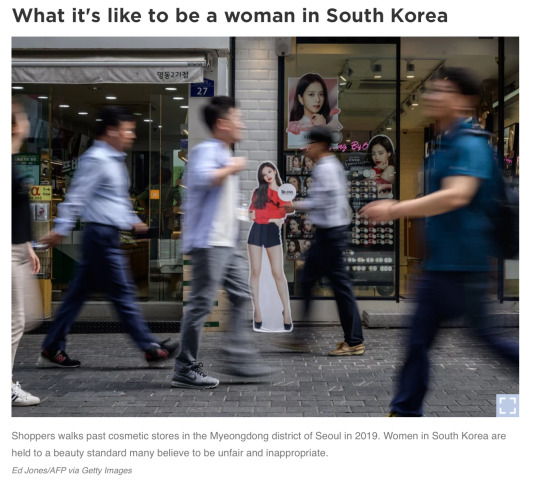
For the past couple decades, South Korea has continued to boast the largest gender pay gap among the countries in the Organisation for Economic Co-operation and Development (OECD). As of 2021, the gender pay gap in South Korea was 31% — more than double the OECD average of about 12%. For comparison, the wage gap is 16.9% in the United States.
South Korean women largely must choose between career and family, with The Economist's glass-ceiling index ranking it the worst country in the OECD for working women in 2022. Strict maternity leave policies at workplaces are one of the reasons for South Korea's alarmingly low fertility rate at 0.8 children per woman — the lowest in the world, according to The World Bank.
Apart from discrimination in the workplace, women are held to a beauty standard many believe to be unfair and inappropriate. There's a stigma against women who do not wear makeup or who have short hair, said Yusu Li, a member of the feminist group Haeil.
Danbi Hwang, another member of Haeil, said if women do not wear makeup to work, coworkers ask, "Do you feel OK? Is something wrong?"
"They respond by directly attacking women's appearance," she said.
The "escape the corset" movement took South Korea by storm in 2019, a rejection of the country's standards of beauty and social pressure to conform.
But these societal expectations toward women still exist. In one notable case, at the Tokyo Olympics in 2021, South Korean archer An San — who won three gold medals at Tokyo — became the target of online abuse from anti-feminists who claimed her hairstyle indicated she was a radical feminist.
When even one's hairstyle can become a reason for verbal abuse and accusations of man-hating, many young women in South Korea are fearful of speaking up about women's rights.
Ellen Kwon, 25, said many young Korean men look down on women for being passionate about gender equality.
Kwon, who has spent half her life in Korea and half in the U.S., said she would not openly talk about gender issues around her Korean friends.
"I know how guys will react," she said. "I know they're going to be like, 'This is another girl talking about gender issues again.'"
"Femi," short for feminist, has become a derogatory label for any person who speaks up about gender discrimination and women's empowerment in South Korea. Hwang, of Haeil, said asking someone if they are a "femi" in Korea is the same thing as asking if they have a mental illness.

"This type of rhetoric is censoring women's voices, especially when they try to support gender issues," said Jinsook Kim, a professor at Emory University who studies online misogyny and feminism. "A lot of women cannot talk about gender issues in public spaces, and they don't even talk to their close friends, because they don't know what their friends think about it."
For this reason, many feminists work online, anonymously. Many of those who don't receive death threats on a regular basis, leading some to leave the country.
With a lack of public figures openly advocating for women's rights, young Korean girls are struggling to find their role models, Kim said.
In the corporate world, women only hold about 21% of managerial positionsand only 5% of executive positions in South Korean companies. Politics reflects a similar makeup. In the legislature, only 19% of seats are held by women. And, according to Kim, there are very few feminist professors teaching at Korean universities.
"It's hard to say there is hope when you look at the overall situation," said Li, of Haeil. "But what makes me hopeful are my fellow feminists, friends, seeing women like me who have short hair with no makeup, and women's rights protests that show we are not alone."
#South Korea#backlash#women’s rights#strict beauty standards#MeToo#Haeil#Ministry of Gender Equality and Family#Korean Women's Associations United#Protecting women and girls from sex based violence means treating men like sex criminals according to anti-feminists#Wage gap#Low fertility rate#Escape the corset#Online abuse of women#Fami
15 notes
·
View notes
Text

Welp I hope my professor enjoys my hot cheeto take for this project. I’m just making some notes before I get writing.
#pls no reblog thank you!!! i still don't have that function that lets me turn off reblogs#idk if this is actually a hot take but you try explaining this to a room completely full of cis women --#-- who think feminist theory stops at the wage gap or the glass ceiling#i hope my point is clear and i'm not sounding like an idiot bigot. it's one of those arguments that i read aloud and my partner is like:#'WAAAIIIT! Let him finish!!' like ik it might sound bad at the beginning dfgfds but i hope not??#basically: as a sort of manifesto i am calling on cis women to 'trouble' their own sense of gender. we live in an individualistic world so -#- harness your individuality and autonomy and say 'fuck that' to conformity. then we might actually have a more inclusive feminist movement.#i'm citing a few different manifestos for including trans women in feminism. that's where this is coming from lol#pls let's include trans women!! and gender-expansive people in general! there are as many ways to be a woman as there are women.#basically i'm advocating for cis women to unlock cis+ if ya know what that means sdfghgfds
11 notes
·
View notes